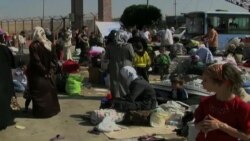As European leaders struggle to deal with an overwhelming flow of migrants, the root causes of the worst refugee crisis on the continent since World War II are under discussion. Analysts agree that desperation is driving people away from their homes, but they have nuanced views about what led to the desperation.
Ivan Vejvoda, a vice president at the German Marshall Fund, said interventions in Iraq and Afghanistan brought extreme fragility, and there was a meltdown after the Arab Spring and little will on the part of Western governments to intervene in Syria.
“The fragility of Syria in particular, the meltdown, was not countered with measures by anyone from the Western alliance, and so we had a worsening of the situation then, compounded also by the migrants coming from sub-Saharan Africa and of course in Libya,” he said.
William McCants, who directs the Project on U.S. Relations with the Islamic World at the Brookings Institution, said the responsibility doesn’t just fall on the West.
“I think it falls directly on the governments who did not listen to their people when they were calling for a peaceful change of regime,” he said. “It falls next to the countries that neighbor it, particularly the wealthier countries, and then I think it falls to the international community to lead.”
McCants said ongoing attacks on civilians, not just by Islamic State but also primarily by the regime of Syrian President Bashar al-Assad, were big contributors to the refugee crisis.
Vejvoda said a diplomatic solution in 2012 with a possible exit for Assad or talks between the fighting partners might have been a preemptive move. But he said these assessments today are done with the benefit of hindsight.
“The circumstances then were completely different, and I think people were simply not aware of what was going to happen, really, this huge flow of populations towards Europe,” he said.
No easy solutions
Daniel Serwer, a scholar at the Middle East Institute, said focusing on what caused the migration “doesn’t help you to solve the problem today. ... I would like to see some safe area, protected area, created in northern Syria and in southern Syria, but I don’t pretend that those things would solve the problem very quickly.”
McCants, referring to some of the Gulf countries, noted that some who have pledged millions of dollars for refugee camps have not been delivering on those pledges. He said he thought more should be invested in camps in areas surrounding the conflict.
“It would be wonderful if European governments and the United States took in more refugees, but I think we have to focus a lot more on the source of where these refugees are coming from and their first stop on their journey, which is usually to these camps that are closer to home,” he said.
Radical infiltration
McCants, who just published a book on the history and strategy of the Islamic State group, also addressed the fears that radical elements may be infiltrating into Europe among the thousands of people crossing borders.
“I think, by and large, the vast majority of people that are coming just want to escape the chaos,” he said, “but you could never say with certainty that bad elements wouldn’t try to slip in, particularly since for Islamic State fighters, some of them, carrying out attacks in Europe is a priority.”
More than 470,000 people have arrived in Europe this year, nearly 40 percent of them from Syria, according to the International Organization for Migration.
The United States plans to issue up to 100,000 refugee visas a year starting in 2017, up from the current 70,000.










